Video
youtube
~Grief is the natural price we pay for loving~
0 notes
Photo
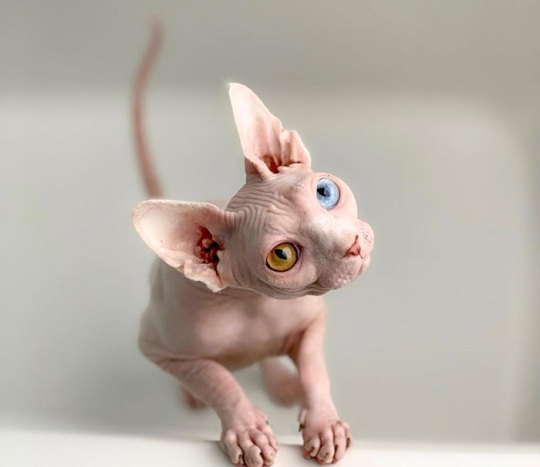

Latin Name: Felis catus
Place of Origin: Canada
Average Lifespan: 8-14 years
Average Length: 30-38cm
Average Weight: 3-5kg
Diet: Carnivorous
This naturally occurring cat breed has become one of the top 10 most popular in the world not in spite of their looks, but because of them! These cats- often described as so ugly they’re cute- have quickly gained a place in the hearts of those who learn to appreciate their beauty.
But these wrinkled good looks come with heaps of specialized care, making these one of the most high maintenance kitties on the market.
Thinking of getting a Sphynx cat? Here are some things you should know:
Personality
We all know the basics of cat personalities, don’t we? Cold, aloof, reserved... Well you can chuck all that out the window with this breed. These affectionate cats- often called velcro kitties- want nothing more than to be on and around their owners. And if you have guests over? Well you can bet they’ll be all over them too. These friendly felines thrive on attention, no matter who’s it is. Because of this, it’s best to look into getting them a friend (like a cat or a dog) if you plan on leaving them alone for extended periods of time. But hey, two pets are better than one, right?

When they’re not curled up next to you they’re bound to be racing through your house, climbing everything in their path and getting into trouble. Think your antiques are safe on the top shelf of your bookcase? Think again. The Sphynx’s athleticism is matched only by their curiosity so if you’re hiding something they’ll want to know what it is (and it won’t take them long to find a way up). With a Sphynx you’ll soon master the art of cat-proofing your house or die trying.
Enrichment
As mentioned above, Sphynxes are athletic, high energy and very smart. If you don’t provide your cat with enough enrichment they will destroy your house. First things first- cat trees are a must. Alright maybe not cat trees specifically, but definitely provide your Sphynx with something to climb so they can get all that energy out in a positive way. In that same vein, making sure your house has a ‘cat superhighway’ (where your cat can travel from one end of the room to the other without touching the floor) is something your Sphynx will thank you for. Cat highways can be made by installing new shelves, adding cat trees or even rearranging furniture. The possibilities are endless!

Grooming
This is were the Sphynx cat loses points… Loses all the points. Alright, that’s probably an exaggeration but there’s no denying the fact that these are some high maintenance cats with a skin routine that’d make Kim Kardashian quake.
For starters, Sphynx cats need regular baths. Because they lack fur to soak up any excess oils they tend to become greasy over time. Experts say that bathing them every 1-3 weeks (depending on how quickly oil accumulates on your specific cat) should be enough keep them from developing skin conditions or leaving sphynx-shaped grease stains all over the furniture. Try not to over bathe them though as this could counter-intuitively lead to them producing even more oil.
Because Sphynx kittens are bathed from birth it’s not uncommon for them to get used to water and maybe even enjoy bath time. That being said, this isn’t always the case so here are some tips to make bath time as enjoyable and stress-free as possible for the two of you:
Use warm water: Sphynx cats get cold really easily. If the water/room is too cold for you take a bath in then it’s too cold for them. Same goes for hot water.
Place a towel/non-slip mat at the bottom of the sink/tub: This lets your cat grip onto something so they don’t feel like they’re slipping
Fill your tub/sink before bringing you cat into the room: Cats are often distressed by the sound of running water. Make sure the water’s about belly-level with your cat
Hold your cat: Keeping a firm (but gentle) grip on your cat will not only keep them from jumping out of the water but your presence might also serve to comfort them. Give your cat a moment to acclimate before bathing them if they’re freaking out.
Use a cup to gently pour water over your cat: Be sure to avoid the head!
Use a wet washcloth to scrub your cat: Be sure to wash between the wrinkles where dirt/sweat/oil tend to accumulate. (Sphynx-safe shampoos will be listed below)
Towel dry your cat as soon as they leave the tub: After rinsing off your cat (by pouring water over them with a cup) and getting them out of the bath you’re gonna want to dry them immediately so they don’t get cold. Don’t use a blow dryer as it’ll scare your cat and irritate the skin. A quick towel dry is all they need (bonus points if you used a towel heater first!)
Never forget the power of positive reinforcement: Use a soothing voice, provide them with treats, try to make the experience as positive as possible and most importantly be patient!
When choosing the right shampoo for your Sphynx there are a few things to keep in mind. First is that cats have very sensitive noses so it’s best to avoid highly scented shampoos. Second, keep in mind that Sphynx cat’s skin is very sensitive. Most breeders recommend using a mild baby wash but there are also some great cat-specific shampoos out there (just be sure they’re designed for sensitive skins). At the end of the day, the shampoo you choose highly depends on your personal preference and your cat’s skin type.
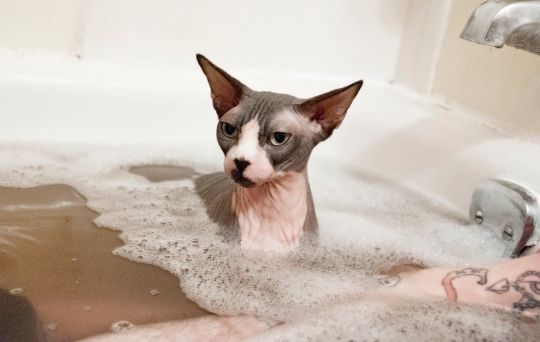
A good way to keep your cat clean between baths is to wipe them down with a damp washcloth or specialized wipes. These cat wipes are especially good at reducing itchiness/dander and keeping the skin moisturized between baths.
Because Sphynx cat’s don’t have eyelashes they’re predisposed to developing what can scientifically be referred to as ‘goop’ around their eyes and face. You can clean this by using a damp cotton ball or wash cloth (clean) to gently clean around their eyes and wrinkles. You could even use all natural hypoallergenic baby/cat wipe (as listed above). Most cats need their faces cleaned on a daily basis but really it depends on how often you spot gunk around your cat’s face
Sphynx cats require ear cleanings about as often as they receive baths since they don’t have ear hair to wick away dirt.. Start by soaking a cotton ball in mineral oil, coconut oil or a commercially available cat ear cleaner. Rub the cotton ball in the cat’s ear (this’ll help soften any built up gunk). Once you’ve softened everything up use a q-tip (again, soaked in your ear cleaner of choice) to gently scoop out the black build up. Only put the q-tip as far in as you can see since going in any further risks damage to your cat’s ear. If you choose to use coconut oil for this process be sure to use the excess as moisturizer for cats with dry skin.
Now on to the feet care- that’s right, these cats need pedicures. Dirt build up between the toes and around the nail is another unfortunate side effect to hairlessness. Again, this needs to be done about as often as they get baths so some owners choose to clean their Sphynx’s feet as a part of the bathing process. Alternatively, if your cat wants to spend as little time as possible in the water, then all natural hypoallergenic wipes are the way to go.You’re also going to want to clip your cat’s nails every 1-2 weeks. This video demonstrates the entire process quite well.
Due to their tendency for grease build up and exposure to the elements some Sphynx cats can develop black heads and pimples. If your cat develops these ask your vet to point you in the direction a cat-friendly antibacterial soap (never use human products without consulting your vet) and wash the problem area with warm water. Once done, you can wipe the area with a witch hazel soaked cotton ball and rinse the entire acne area with cold water (wash it well as licking witch hazel might make your cat sick). In extreme cases some vets may even recommend benzoyl-peroxide pads (i.e. Stridex Pads) but I wouldn’t use them otherwise. Some people choose to pop their cat’s black heads. Though this does work not all cats tolerate being squeezed so this treatment plan may result in scratches. Still, it’s something to consider and ask your vet about.
Climate & Weather
Due to their hairlessness Sphynx cats are just as susceptible to climate as we are. Because of this, they should always be an indoor only cat (with any outdoor time being heavily regulated). Funnily enough, leash training and walking your Sphynx might be a great way to let them enjoy the outdoors (and greet all the neighbors) in a safe way.
First, lets talk about the cold. Since they lack hair these cats lose body heat very fast (coincidentally this is why they feel so hot to the touch). As any Sphynx veteran will tell you, this breed is always cold. Can’t find your pet? They’re probably curled up under your blankets or snuggling next to another pet for warmth. Because of this, getting your cat a warm bed for them to heat up in is an absolute must. Another important item to add to the shopping list are sweaters. Though some people may scoff at the idea of putting Fluffy in a turtleneck this breed definitely needs it. As a general rule of thumb, if it’s too cold for you to feel comfortable naked then it’s too cold for your cat.

Now time to tackle a different environmental issue: the sun. Sphynx cats- like humans- will tan, get sunburnt and potentially even develop skin cancer if exposed to the sun for prolonged periods of time. Luckily, there are ways to avoid this. First, you should try to limit outdoor time to hours when the sun is less intense (i.e. early morning, late afternoon). Secondly, you could consider getting your cat a ‘sun shirt’ (any lightweight breathable shirt will do) to block the sun’s rays from as much of their body as possible. Lastly, there’s sunscreen.
Sunscreen is kind of a tricky subject when it comes to Sphynx cats due to how sensitive they are. Avoid sunscreens containing zinc oxide as it can cause anemia. Generally speaking, using sunscreen specifically designed for cats is likely your best bet (though some spray-on child sunscreens may work). That being said, not all cat or human products are Sphynx safe so if you feel your cat needs sunscreen then it’s best to ask a vet which brand is right for you.
Litter Boxes
If you’ve owned cats before then I won’t have to tell you that poop's cat-to-litter box transition isn’t always a clean one. I’m talking about what some owners euphemistically refer to as dingleberries (because ‘hardened poop hair’ didn’t have the same ring to it). Sometimes when cats go to the bathroom poop can get caught on their fur and harden into a poop cocoon (for lack of a better word). Fortunately, without fur Sphynx cats never have dingleberries! Unfortunately this does leads to new issues. Though poop may not get caught on their fur it might stay on their skin, ready to be smeared all over the house. Fortunately this issue can be minimized significantly by choosing a proper diet that’ll cause the stool to firm up (ask your vet about the best choice for you) and cleaning the litter box as often as possible. Still, as a Sphynx owner you should be prepared to wipe your not-so furry friend’s bum from time to time.
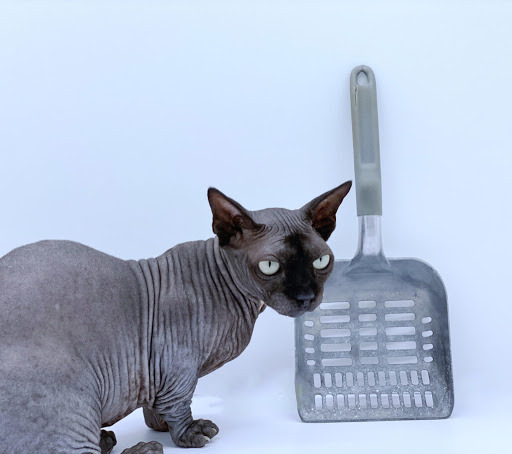
Common Health Issues
Fortunately, Sphynx cats tend to be a very hardy breed as far as hereditary diseases go. The only major genetic concern for these cats is Hypertrophic Cardiomyopathy (HCM), a disease found in all domestic cat breeds. HCM is characterized by the thickening of the heart’s wall and can potentially be deadly. A responsible breeder will screen their cats for this disease on a regular basis, but this doesn’t guarantee that a kitten won’t develop it at some point in their lives.
Though some cats with HCM may present labored/rapid breathing, open-mouthed breathing, or lethargy most cats with this condition tend to be asymptomatic. If you suspect your cat might be suffering from HCM, take them to your vet as soon as possible.

Sphynx & Cat Allergies
Ok, I get it. Sphynx are a lot of work. But hey, at least they’re hypoallergenic, right? WRONG. Allergies come down to the Fel-d1 protein found in cat’s saliva and the natural oils produced by their skin, something all cats have. So fur isn’t involved at all? Well, not exactly. When cats groom themselves they inadvertently coat their fur with saliva. When cat’s shed, not only do they get hair everywhere but also the Fel-d1 protein dried to their fur. Because Sphynx cats don’t have any hair to shed it means their allergens are relatively self contained.
That being said, there are plenty of other ways to come in contact with a cat’s saliva/body oils that don’t involve hair. Picking up a cat toy, re-filling their water bowl and even petting your cat are all ways to come in contact with Fel-d1 (which Sphynx cats produce just as much of as any other cat). If you ask me, adopting a cat you can’t pet sounds like a crime- especially when they’re this affectionate.
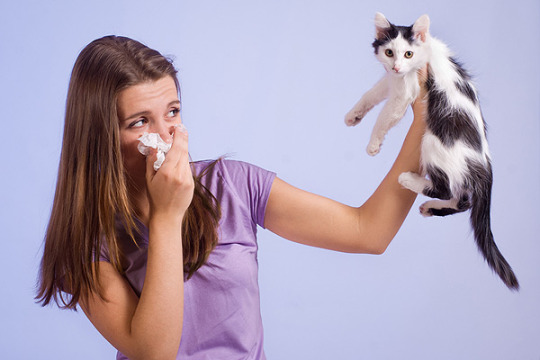
Though there’s no such thing as a totally hypoallergenic cat (yet) that’s not to say you don’t have options. Allow me to point you in the direction of the Balinese and the Siberian. Both of these cat breeds (which funnily enough have a ton of fur) are renowned for their limited production of the Fel-d1 protein and are both an excellent option for any allergic cat lover.
Acquiring a Sphynx Cat - Warning Signs
So you’ve decided you still want a Sphynx cat, specialized care be damned! Getting your hands on one of these naked beauties, however, is a little tricky. The increasing demand for this breed has created a rise in the amount of scammers looking to make a quick buck off of prospective cat owners. A quick google search will provide dozens of examples of people who bought a cheap Sphynx kitten online only to be sold a normal kitten that had been cruelly de-haired via razor and chemical hair remover. This scam- an unambiguous case of animal abuse- has become appallingly common and something any prospective Sphynx owner needs to look out for. Here are some tips for avoiding these scams:
If it seems too good to be true, it probably is: Here’s the sad reality- Sphynx kittens aren’t cheap. Vaccinating, breeding, feeding and socializing kittens takes time and money and a genuine Sphynx kitten will reflect that. If the kitten you have your eye on is listed for less than $1200, tread with caution.
Trust your gut: If you feel uneasy at any point during the purchasing process, leave and take your money elsewhere.
Make sure the cat is healthy: Before handing over your money check the cat over for any signs of scarring or injury. Their eyes should be bright and alert.
Get a look at the facilities: Because many breeders breed from home it’s likely you’ll only be allowed to visit once a deposit for a percentage of the kitten’s price has already been paid. However, if your breeder refuses to let you pick up your kitten from their breeding facilities and will only meet you at a third party location- run. Meeting your kitten’s parents and making sure they’ve all been kept in good conditions is super important and something you should always try to do.
Stalk their social media: Find out if they have a social media (Facebook, Instagram, etc.) where they post pictures of their cats, kittens and facilities. Do the cats in the photos look healthy? Do they post photos of their parents? Are the only available photos staged? Does their environment look clean? Are they being socialized? If you can’t visit the breeder in person and have to have the kitten shipped to you this may be as close as you’re going to get to visiting the facilities.
Find a registered breeder: There are plenty of cat breed associations around the world, most of which keep list of breeders with certified cats. Finding a breeder registered with one of these associations is a sure-fire way to know your kitten is legitimate. (TICA: x,x) (CFA: x,x)
Take your kitten to the vet asap: You should be doing this any time you get a new animal regardless of where it’s from or what it is.

If buying a $1200+ kitten seems too expensive I’m happy to report there are other ways to bring one of these wonderful cats into your lives. Believe it or not, there are plenty of purebred cats that need to be rescued. So if you’re getting a Sphynx, why not save a life in the process? (X,X,X,X,X,X)
Parting Words
If you’ve made it this far and still think getting a Sphynx is worth it, then congratulations! Though they are a lot of work Sphynx owners will tell you that it’s all worth it and that once you have a Sphynx, no other cat will do! Whether that’s true or not, this breed will undoubtably make an amazing pet for the right person. If what you want from a pet is someone to snuggle up with under the blankets, then a Sphynx may just be your perfect companion.

#sphynx cat#large mammals#cats#cat breeds#pets#animals#carnivore#Moderate Size Requirement#10-20 Year Lifespan#Kid Friendly#care sheets
0 notes
Photo
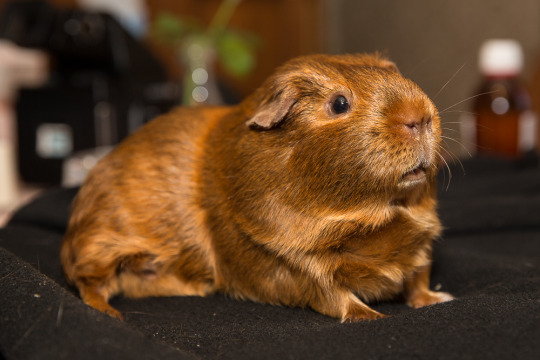

Satin Guinea Pigs (And Why You Shouldn’t Buy Them)
When you set out to learn about cavies it doesn’t take long for satin guinea pigs to pop up in your research, and with good reason! These hollow-haired absolutely stunning coat that shines and appears to have a glassy coating. This beauty, however, comes with a steep price.
Though satin guinea pigs aren’t a breed per se, several recognized guinea pig breeds (abyssinians, americans, peruvians, teddies and silkies) can present the satin gene. This recessive gene is linked to something known as satin guinea pig syndrome, an incurable genetic disease that can cause these animals extreme pain. SGPS or Fibrous Osteodystrophy is a metabolic bone disease that is characteristic of satin guinea pigs (and only satin guinea pigs).
Under normal circumstances, PTH (parathyroid hormone) is secreted as a response to low calcium levels. In order to raise calcium levels back to normal, it increases bone resorption (a process by which calcium is taken from the bones to raise levels in the blood stream). Usually this mechanism is balanced out by the action of the hormone Calcitonin which promotes the storage of calcium in the bones by reabsorbing calcium in the kidneys.
For piggies with SGPS, however, the reabsorption of calcium in the kidneys is highly inefficient. This chronic and significant calcium deficiency leads to an overactive bone resorption which causes bones to decalcify (osteoporosis) and form fibrous tissue to replace the boney matrix (osteitis fibrosa). This chronic degenerative disease is often diagnosed in young guinea pigs who go on to lead short, painful lives.
The skeletons of cavies with SGPS often present dental and skeletal deformities, kidney issues, hyperphosphatemia and hypocalcemia. Their weakened skeleton is highly susceptible to fractures. As the disease progresses walking will become progressively more difficult until it becomes impossible all together.
Breeding satin guinea pigs is a risky endeavor. Pregnant sows with the condition require extra calcium to produce milk and form fetal skeletons. This increased calcium requirement only works to accelerate the rate at which bone resorption occurs. This cause hypocalcemia, a disease expressed through seizures, paralysis and death. Even if the sow successfully carries her pregnancy and gives birth, milk production is equally taxing in terms of calcium requirement and presents the same risks as pregnancy. Because of this, mortality rates for sows with SGPS during or shortly after pregnancy are very high. As for the the babies, low calcium content in their mother’s milk will lead to hypocalcemia in them as well. Because of this they are often smaller than others of their kind.
SGPS currently has no cure. Though some owners choose to administer supplemental calcium, there is no evidence that this helps prevent or cure SGPS. Vitamin D3 plays a significant role in the reabsorption of calcium in the kidneys, because of this it’s beneficial to provide guinea pigs with SGPS with a UVB bulb to help prevent D3 deficiency and help delay the advancements of this disease. The best thing you can do for a piggy with this condition, however, is just to help manage their pain. Regular x-rays and vet visits will be necessary to check on the spread of the disease but once the bones are completely decalcified the only humane option is to put them down.
So please, do not buy satin guinea pigs. Be it from a breeder or a pet store you encourage the breeding of sick animals. I would only ever recommend getting a satin guinea pig if you’re adopting one from your local rescue, but always keep in mind that you’re signing up to get attached to an animal with a tragically short and painful existence.
1 note
·
View note
Photo


Latin Name: Cavia porcellus
Native To: South American Andes
Average Lifespan: 4-8 Years
Average Size: 20-25cm
Average Weight: 0.7-1.2kg
Diet: Herbivorous
The confusedly named Guinea Pig is neither a Guinea native nor closely related to pigs. Yet according to the people of the South American these lively rodents do have one thing in common with their porcine namesakes: they taste good. Though I can’t attest to the merit of these claims (nor would I want to) I can confidently say that they do make wonderful pets.
These vocal critters have long since outgrown their humble livestock origins and are now a go-to pet for parents trying to teach their kids a valuable lesson in responsibility via a new furry friend.
Thinking of getting a guinea pig? Here are some things you need to know:
Behaviour
The most important thing to note about guinea pigs is this: they’re social animals. In order for your cavy to be happy it has to at least be kept as a pair (in this case of an animal unfit to live peacefully with others a divider should be placed between two halves of a large enclosure so as to allow socialization without the risk of injury to either or both of your pets). No amount of one-on-one cuddling with your rodent will replace the need for companionship. In short: if you can’t get two of them, you can’t get them at all. Period.
This may seem harsh but the amount of times I’ve encountered multiple solitary guinea pigs is honestly disheartening. Switzerland went as far as to outlaw the purchase of lonely cavies, classifying the act as a form of animal abuse. Frankly, I wish more countries would adopt this policy. So please, do the right thing and get a pair (and if you don’t want a bunch of babies running around be sure to get the same gender for both of them). Remember that when introducing a new guinea pig into a pre-established herd you need to do it slowly to ensure it’s accepted.

Now, with that disclaimer out of the way let’s talk about all the fascinating quirks these guys have! You know how dogs get zoomies? Well imagine that but on a smaller scale and intercut with small excited hops. The already adorable behaviour is given an equally adorable name- popcorning.
Another noteworthy thing to know about these guys- they are extremely food motivated (aren’t we all?) and are permanently hungry. Some owners have used this to their advantage to train their herds to come when called, use a litter box and even perform tricks (x,x). If there’s food on the line, they’re your number one student. Even without training most guinea pigs learn to recognize sounds like the fridge door opening, the crinkle of a bag of lettuce and even the footsteps of a specific person in the house. Anything and everything related to feeding time is going to receive loud wheeks of approval from the peanut gallery.
And when I say loud, I mean loud. If you enjoy your peace and quiet you better find some other critter to share your home with. These guys are always chattering on about something and care little about what time you have to get up for work tomorrow. Happy? Your guinea pig might start to purr. Angry or flirty? Don’t be surprised if they start rumbling. Stressed? Chirping may follow. These little critters seem to have a million noises for a million different things.
Enclosure
Your guinea pig duo are going to need at least 7.5 square feet of continuous space, so though they’ll definitely enjoy that second floor it doesn’t factor into the base size calculations. Remember, more is always better and whatever space you give them is space they’re going to use.

It’s important to note that guinea pigs can’t sweat so it’s important not to place your enclosure near a direct heat source (stove, sunny window, fireplace, etc.). Their ears are also really sensitive so keeping them near speakers and such is also a bad idea. They thrive on being near the action and will enjoy hanging out wherever you spend most of your time, be it the living room or a study (you can even keep them in your room if you’re a heavy enough sleeper).
Most enclosures you’ll find in pet stores simply aren’t going to be big enough to comfortably house your guinea pigs so it’s better to research the cage you want before you go in to buy it so as not to rely on the “expertise” of pet store employees. Though there are numerous commercially available cages that meet (and exceed) the 7.5 square foot minimum, many guinea pig owners prefer using build-it-yourself C&C Cages (short for cubes & coroplast). These types are cages are easily customizable and expandable, made from easy to find materials and are often considerably cheaper than the ill-fitting cages you’ll find at your local pet store. Though building your own C&C cage is fairly simple there are also online stores where you can order a variety of colors an layouts. If you’re handy enough, you could even opt for a hand built wooden enclosure.
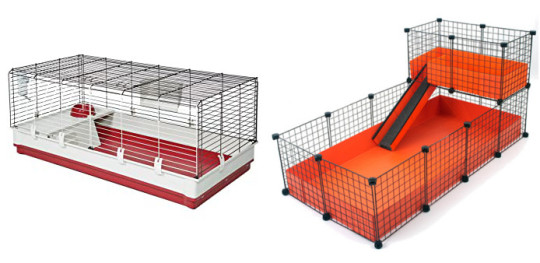
Just be sure to avoid wire bottomed cage, provide shelter if you decide to keep them outdoors and add a lid/rood if you have any pets that might try and make a quick snack of their new roommate.
Bedding
When choosing the right bedding for your cavy you want to be sure to get something soft, absorbent, non-scented and dust free. The dust free part is incredibly important as not only will dusty bedding make cleaning a nightmare but it can also cause some serious breathing issues for your pet. The top three beddings used by guinea pig owners are:
Paper
Fleece
Aspen
Each of these comes with their own pros and cons. Paper bedding, for example, can be dangerous should your guinea pig choose to eat it (unlikely but still possible) and lower quality brands can be quite dusty. Because of this, I’d stick to fleece or aspen. Still, I’d highly recommend doing your own research into each of these to decide which of them is the right choice for you.
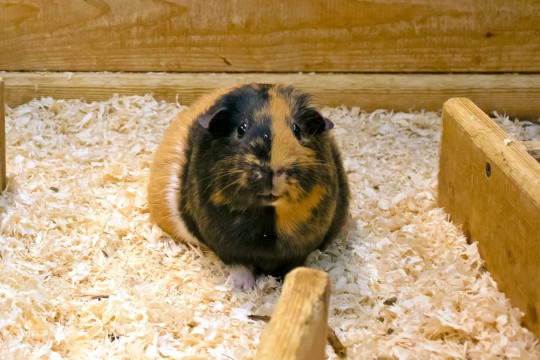
As with any animal there’s also bedding to avoid at all cost.
Cedar, pine and other softwood chips/shavings can be super dangerous to your pet’s health due to all the dust, oils and phenols.
Clumping cat litter. All it’s clumping abilities come from the use of chemicals that make it unsuitable to live in full time.
Corn husks. Prone to mold and could cause intestinal blockage if ingested
Straw. It’s not absorbent at all and the pooling of urine and feces will create a dangerous breeding ground for bacteria. It’s also not soft at all and could hurt your guinea pig.
Enrichment
Not only do guinea pigs need environmental enrichment to stay mentally and physically active but watching them play is also one of the best parts of owning them! They really enjoy using tunnels and hides (x,x,x) as it makes them feel safe and secure (remember they’re a prey animal). Chew toys (like willow balls, grass balls and wood toys) are great to help them wear down their teeth. Also consider getting them a foraging toy of some sort where they can work for their food. As I stated earlier, guinea pigs are incredibly food motivated and you can be sure that they’ll spend hours figuring out how to get treats. Fleece forests, ball toys (x,x) and soft beds are also popular options. Making DIY toys is also an easy and fun thing you can do for your guinea pigs. Rearranging your cage set up from time to time could also encourage your cavies to explore.
**Do not purchase a hamster ball or wheel for your guinea pig** Guinea pigs lack the flexibility that hamsters have and these toys will hurt their spine.
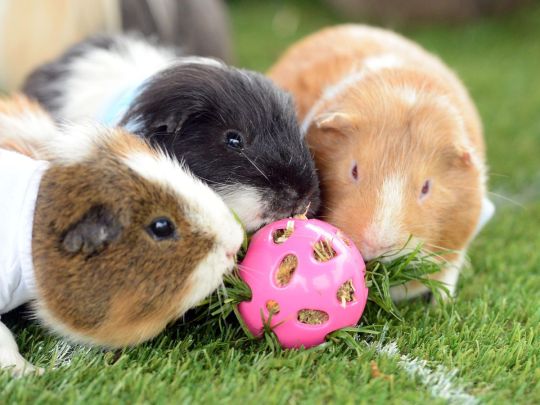
Another way to provide enrichment is to provide floor time for your guinea pigs a few times a week (experts recommend they get floor time at least 3 days a week). This can be done indoors or outdoors via a designated room or play pen. When setting up your floor time area just be sure to guinea-proof it and keep the area free of anything they could eat that would hurt them. If you decide to have floor time outside be sure to use a covered pen and keep and/or eye on them so birds don’t swoop in for a snack.
Feeding
Guinea Pigs require a varied diet of hay, veggies, fruits and high quality pellets. For starters, guinea pigs require hay 24/7. Timothy Hay should make up the vast majority of your pet’s diet as it’s high in fiber, low in calories and strong enough to help wear down your cavy’s teeth. Though other types of grass hay (like botanical hay, orchard gras & oat hay) can help spice up their diet and provide a variety of textures, timothy hay should always make up the bulk of their diet. Legume hays (like alfalfa and clover) should generally be avoided. Though not harmful, it’s high calorie content and low fiber amount means it should only be fed in moderation and is unfit as a nutritional staple. There are exceptions, though. Pregnant, lactating or baby guinea pigs might benefit from the extra calories and calcium these hays provide. Some vets may even recommend it for sick or weak individuals. Remember to store your hay properly to maintain it’s freshness, avoid mold growth and keep the nutrient levels high.
The second fundamental part of your pet’s diet is commercial guinea pig feed. Each of your guinea pigs should get 1/8 Cup of high quality pellets per day. Be sure to choose high quality pellets, timothy-hay based pellets are ideal for adult cavies (though alfalfa pellets can be used for young cavies). Be sure to store it properly to avoid vitamin C degradation. You’re going to want to serve them their pellets in a wide and shallow ceramic bowl that is difficult to tip over and place it far from their typical bathroom area.
Lastly: fresh fruits and vegetables. You should provide your guinea pig three servings of vegetables a day, with leafy greens accounting for at least one of those servings and no more than one serving of any given vegetable per day. Remember, variety is important for you pet to receive all the nutrients they need. Also remember that certain vegetables, though harmless in small quantities, can become dangerous or unhealthy if fed too often. Fruit can be provided as a treat and account for 1-2 servings of food per week. To find out the serving size and how often certain foods can be fed I recommend checking out this helpful chart. If you decide to introduce a new food into you cavy’s diet, do it slowly to avoid upsetting their stomach. And remember, you can always turn to google if you’re unsure about which fruits/vegetables are safe to feed to your pet.
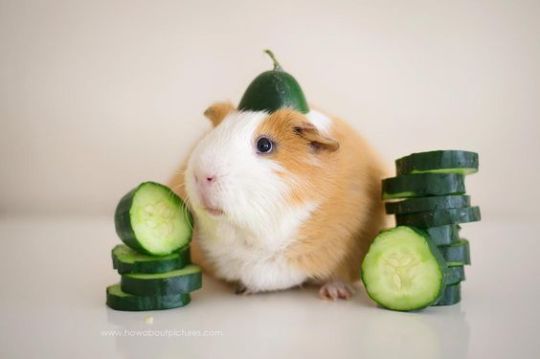
Guinea pigs (like humans) don’t produce their own vitamin C which can leave them susceptible to scurvy. Upon hearing this many worried owners may rush to purchase vitamin supplements for their new pets. In truth, their vitamin C requirement is easy to meet so long as you provide a varied diet of fresh fruits/veggies and store your pellets correctly. If you’re still worried, however, you can choose to supplement your cavy’s diet with guinea pig vitamin C tablets which come in the form of a treat. Some people may choose to sprinkle human vitamin C tablets into their pet’s veggies. The recommended dose of human vitamins is a quarter of a 100mg tablet (be sure it only has vitamin C and isn’t a multivitamin, though). Either way, supplementation is often unnecessary. If you’re worried, consult your vet.
Now, as with our previous categories, there are also some feeding don’ts:
Do not add vitamin C to your guinea pig’s water. Though this kind of supplementation is available in many pet stores it may cause you pet to stop drinking their water all together which will cause serious problems.
Avoid commercial guinea pig treats. These offer no nutritional value and are a drain on your wallet. If you want to give them a treat for a special occasion, give them fruit.
Avoid multivitamin and mineral wheels. Like with vitamin C they tend to be unnecessary if you provide your pet with the proper nutrition. Furthermore, the bleaching/glue used on them can actually be harmful for your guinea pigs.
Water
When buying the equipment you’ll need for your guinea pig you’re likely to find yourself having to decide between purchasing a water bottle or a water bowl. Though advocates for water bowls claim they’re a more natural way of drinking most guinea pigs have been raised since birth to use a water bottle and may refuse to drink out of a water bowl (granted, I’ve also heard tell of guinea pigs where the opposite is true).
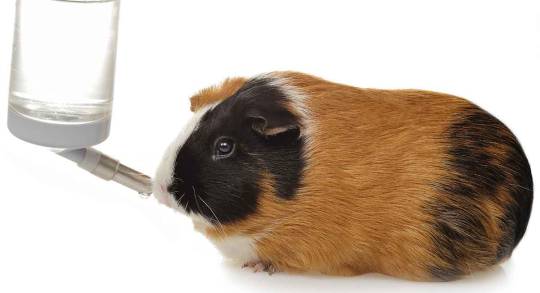
In reality, water bottles are an all around better option for your pet. Firstly, water bottles are considerably more hygienic. It is impossible to keep bowls clean with these guys. Substrate, feces- you name it. Soon enough that water is going to become a breeding ground for bacteria. Secondly, guinea pigs are notorious for knocking over their bowls. Though this may not seem like a big deal, guinea pigs can dehydrate very quickly and an empty water bowl for an extended period of time could have serious consequences.
That being said, water bottles are not without their issues. For one, they have a tendency to break and empty themselves out. This feeds back to the issue of dehydrating. Be sure to take extra precautions and place at least two water bottles in your enclosure and fill them with fresh water daily.
Cleaning Your Enclosure
Guinea pig enclosures require spot cleaning 1-2 times a day. In the case of loose bedding like paper and aspen this means taking out any soiled bedding and replacing it with fresh bedding. If you’ve decided to use fleece as a bedding this means using a dustpan brush or vacuum to remove any feces and loose debris.
You’ll also have to deep clean your cage at least once a week. For loose litter, this involves completely replacing the bedding in your enclosure (dustpans are the easiest way to do this). For fleece, it involves replacing the used one with a new line and sending the soiled one to the washing machine (just be sure to shake off any feces/hay first). You should disinfect your enclosure while it’s bedding free using a solution that 1/2 white vinegar and 1/2 water. You’re also going to take this opportunity to wash your food bowls and water bottles to avoid the build up of bacteria and algae in these containers.
Remember, cleaning is an ideal time to give your guinea pig floor time!
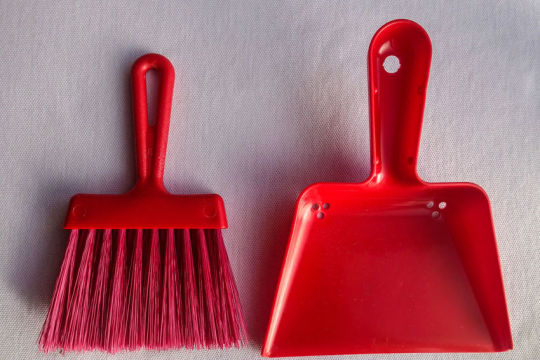
Guinea Pig Grooming
Grooming requirements will vary greatly depending on the breed and fur type of your guinea pig. Short haired guinea pigs can get away with a weekly brushing with a soft bristle brush to help control shedding. Long haired guinea pigs, on the the other hand, require frequent (if not daily) brushing with a wide toothed metal comb to keep the fur bedding and mat free. Remember, should your pet present a mat it’s better to cut it out as trying to brush it could hurt your guinea pig. Your long-haired cavy will also need hair trimmings so investing in a set of hair dressing scissors is a must. Many owners choose to keep the fur around their bottoms short to avoid feces/urine getting trapped there.

Guinea pigs have a grease gland at the base of their spine which could become over active with some individuals (typically males). An over active grease gland will leave the fur in that area tacky, greasy and susceptible to infections. If you notice an excess of grease you should let the affected fur soak in coconut oil for a few minutes before washing the area with guinea pig-specific shampoo. If this doesn’t work, using mild dish soap will do the trick. Keeping the fur in this area short will also help with this issue.
Bathing should be kept to a minimum with your guinea pig as it causes stress and leaves them susceptible to the cold. You should bathe your guinea pig about twice a year. Granted, additional baths may be necessary as a form of parasite treatment or to remove stuck feces/urine (though the latter can be done with a butt bath as opposed to a full bath). If your guinea pig does need a bath do so with warm shallow water in a warm room and use guinea pig-specific shampoo. Be sure to fully rinse them off and towel dry them to the best of your abilities (blow drying isn’t recommended as the noise/heat can hurt your sensitive cavy). Once done, give them floor time in a warm room until they finish drying. Never put your guinea pig back in his cage while he’s still wet.
Aim to clip your guinea pig’s nails once a month (some individuals may require more frequent clippings). When doing so be careful and avoid cutting the quick (the blood vessel in the nail). On light colored nails, the quick is easily identifiable as the red part at the base of the nail. If you do accidentally cut the quick your cavy will be in pain for a few moments and his nail will begin to bleed- don’t panic! The bleeding can be easily stopped by pressing the nail into styptic powder/pencil, flour or cornstarch. Don’t place your guinea back in their cage until the bleeding has completely stop. If you’re uncomfortable doing this yourself you can always ask your vet/groomer do it for you (or teach you how to do it).

You should clean your guinea pig’s ears once every two weeks. This is especially important for older cavies who’s ears have a tendency to become crusty. Start by adding a few drops of mineral/olive oil to your guinea pig’s ears and massaging it in to help soften any gunk. Then you can start cleaning the ears out using q-tips. Don’t go digging in parts of the ear you can’t see as this can cause damage to the internal ear.
Now, here’s one part of grooming that not many people hear about until after they purchase their cavies: boar cleanings. Boar cleaning refers to the extra care male guinea pigs' genitals require (particularly their penis and perineal sac) as they get older. It’s somewhat difficult to explain the process of this so checking out these (x,x) links will give you an idea of what you’ll need to do for your boys as they get older. Be warned- the links aren’t necessarily pleasant to watch but they are a very important part of keeping male guinea pigs. Remember to check your male cavy’s ‘bits’ every four weeks and carry out a boar clean (or pay your vet to clean) as needed.
Handling
Guinea pigs don’t naturally enjoy being picked up. That being said, a well socialized cavy is far more likely to tolerate it than one that never leaves it’s cage. When picking a guinea pig up be sure to use one hand under their chest/behind their front legs and the other to support their bottom so that your pet feels secure and their spine remains aligned. From there you can bring you guinea pig up to your chest, using your free hand to hold them in place if they’re particularly skittish.

Though guinea pigs are often purchased as a child’s first pet I’d generally discourage young children from picking them up. Though guinea pigs aren’t particularly prone to bitting they can struggle and even scratch which could lead to your child dropping and seriously hurting a cavy. For kids I’d recommend having them sit down and have an adult place the guinea pig on their lap (a fleece bed could serve as an extra layer of protection so they don’t get dirty if the guinea pig decides to poo or pee on them). Having the cage at a level where your kid can pet their pets without taking them out of their cage is another option.

When petting your guinea pig try your best to stroke in the direction that their fur grows (easier said than done for wild haired abyssinians). Most guinea pigs dislike being pet on their rump as it’s a sign of aggression amongst others of their kind.
Common Health Issues and Warning Signs
Guinea Pigs, like all animals, are prone to getting sick. Unfortunately the signs aren’t always obvious if you don’t know what to look for. Be sure to take you guinea pig for regular check ups (1-2 time a year) and call your vet if you suspect something’s wrong.

The following are a list of common health issues to look out for:
Respiratory Infections: This is one of the most significant conditions your pet may face. Stress, overcrowding, pregnancy and other illnesses are all risk factors for your guinea pig developing this condition. Consult your vet if your guinea pig stops eating, sneezes, has trouble breathing or presents with abnormal discharge from their eyes/nose (note that a milky white substance being secreted from their eyes is normal for healthy piggies).
Diarrhea: Diarrhea isn’t something to be taken lightly with cavies as they can quickly dehydrate and die. If your pet stops eating, playing, losing weight or presents with diarrhea they should be taken to the vet immediately.
Scurvy: Vitamin C deficiency is a subject I touched on earlier in the feeding category. If you notice your pet has a rough coat, stops eating, doesn’t walk, seems to be in pain, has swollen feet/joint or has bleeding ulcer on their skin/gums it’s likely they’re suffering from vitamin C deficiency. Consult your vet about the best way to supplement vitamin C into your guinea pig’s diet and adjust their food to provide more nutritionally balanced meals.
Tumors/Abscesses: Though these are two different things they present in similar ways and often need surgical intervention to be fixed. If you notice any abnormal mass on your guinea pig contact your vet.
Urinary Problems: Guinea pigs are prone to both urinary infections and the development of bladder/kidney stones. If you notice your pet stop eating, peeing blood, straining to pee, hunching over, small frequent urinations or no urination at all contact your vet immediately.
Parasites & Skin Problems: Parasites (typically lice, mites, fleas and ringworm) are prone to making homes out of guinea pigs. If you notice your pet itching, losing hair or developing scabs contact your vet.
Barbering: Barbering is when your guinea pig begins chewing it’s own (or it’s cage mate’s) hair. This is typically a sign of boredom that indicates your enclosure is lacking enrichment. Offer them more to do in the form of chew toys, balls or foraging opportunities.
Bumblefoot: This condition, characterized by the development of infected sores on your guinea pig’s feet, has a deceivingly cute name. This most often happens with guinea pigs who are overweight, are kept on a wire bottomed cage or in unsanitary conditions. Treating bumblefoot is often difficult but by working with closely your vet can be cured. Over all though, it’s best to keep your pet in a clean, flat-bottomed cage to avoid the issue entirely.
Spurs: This is characterized by the development of a flap of tough skin protruding from your pet’s feet. There don’t seem to be any risk factors and the spur itself isn’t painful and can be easily snipped off using nail clipper (just be careful not to get the skin). The real issue is that, if left untreated, they could get caught and tear the skin on their feet. This results in bleeding and even bumblefoot.
Parting Words
Guinea pigs are wonderful little critters that’ll make the right owner very happy. If you do decide to bring a pair of these lovable pets into your life, consider rescuing a guinea pig from your local rescue! You’ll be surprised by the variety of guinea pigs you’ll find are looking for their forever home.
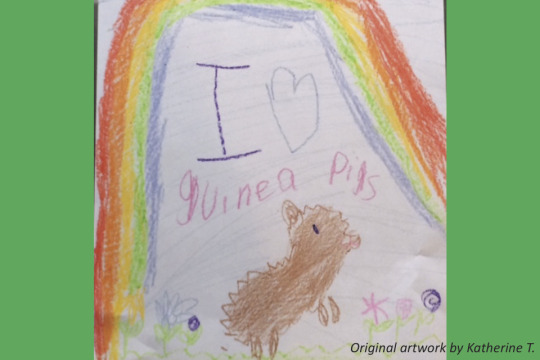
#small mammals#guinea pigs#care sheet#pet care#cavvy#herbivore#2-10 Year Lifespan#Kid Friendly#guinea pig care#cavy#animals#care sheets#pets#Small Size Requirement
0 notes